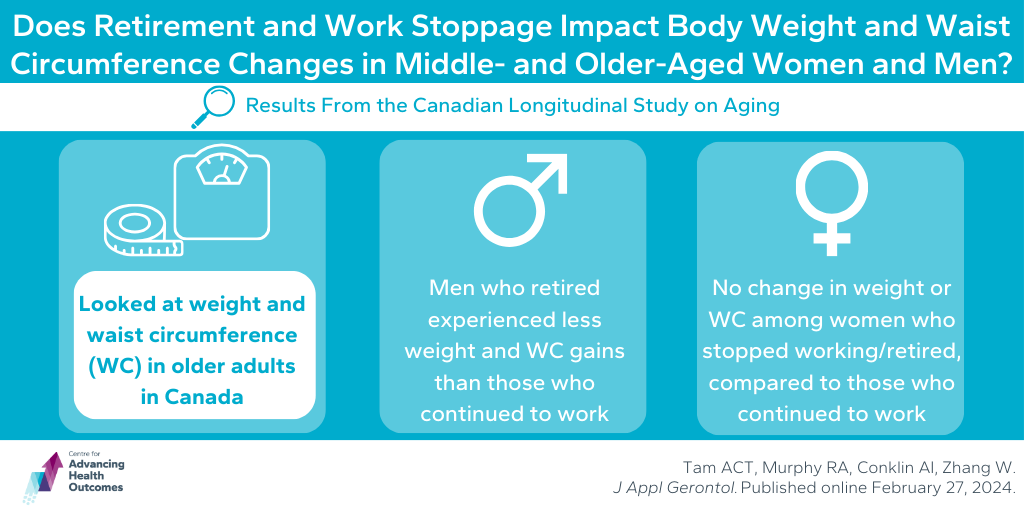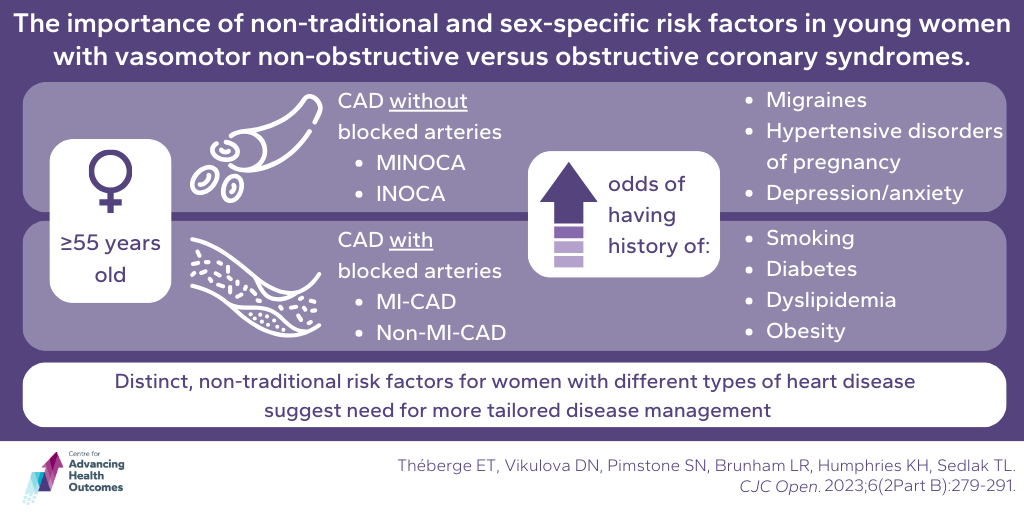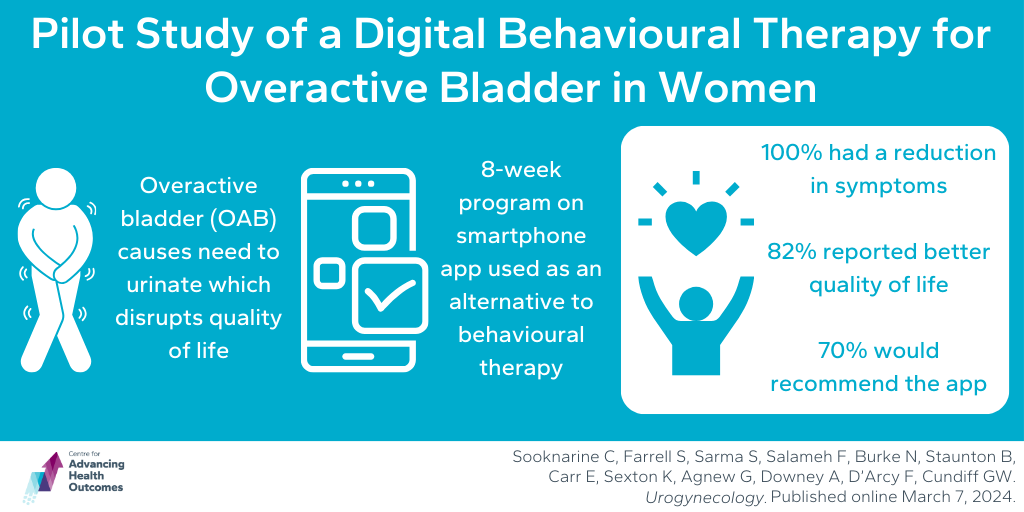The Evidence Speaks Series is a recurring feature highlighting the latest in Advancing Health research. This series features summaries of select publications and is designed to keep media and the research community up to date with the Centre’s current research results in the health outcomes field.
To ensure this research is quick and easy to share, you are welcome to save the social cards and use as you see fit.
Change of employment status may not affect body weight in older adults
Tam ACT, Murphy RA, Conklin AI, Zhang W. Does Retirement and Work Stoppage Impact Body Weight and Waist Circumference Changes in Middle- and Older-Aged Women and Men? Results From the Canadian Longitudinal Study on Aging. J Appl Gerontol. Published online February 27, 2024.
Advancing Health’s Alex Tam, Dr. Annalijn Conklin and Program Head — Health Economics, Dr. Wei Zhang examined the impact of employment status change (employment transitions) on body weight compared to continuing to work among middle-aged and older adults in Canada. With an aging workforce, there will be increases to the number of employment transitions in Canada, and with employment being an important determinant of health, understanding the impact of these employment transitions on health can inform workplace and community programming. The researchers compared workers who either continued working, entered retirement, or stopped working and considered change in both measured body weight and waist circumference (WC). Men who retired tended to experience less weight and WC gains than men who continued working, and while findings for men who stopped working were not statistically significant, point estimates suggested potentially less gain as well. Although women who stopped working had the greatest predicted pre–post increase in WC, in general, women who retired or stopped working did not experience body measurement changes that were different from women who continued working. These findings indicate that retirement may not put women or men at increased risk of weight gain, and it may even help men avoid weight gain that is often seen in middle-aged and older men who continue working.

Women with heart disease may need different treatments depending on type
Théberge ET, Vikulova DN, Pimstone SN, Brunham LR, Humphries KH, Sedlak TL. The importance of non-traditional and sex-specific risk factors in young women with vasomotor non-obstructive versus obstructive coronary syndromes. CJC Open. 2023;6(2Part B):279-291.
Heart disease is the top cause of premature death among Canadian women. In this study, Advancing Health Scientist, Dr. Tara Sedlak, and a team including Program Head of Cardiovascular Health at Advancing Health, Dr. Karin Humphries, examined different types of heart disease in young women. The team distinguished between heart attack (myocardial infarction, or MI) with no blocked arteries (no obstructive coronary artery disease (CAD)), known as MINOCA, heart disease with no obstructive coronary arteries (INOCA), and heart disease (coronary artery disease, CAD) with blocked arteries) with or without MI. They studied 254 women between 2015 and 2022 to see which factors were linked to these types of heart disease. They found that migraines and pregnancy-related high blood pressure (preeclampsia/gestational hypertension) were more common in women with MINOCA and INOCA, while diabetes and smoking were linked to premature CAD with blocked arteries. These non-traditional risk factors for the various types of disease suggest that they might have different causes and therefore women may need specific treatments depending on what type of heart disease they have.

A smartphone app may improve Overactive Bladder treatment
Sooknarine C, Farrell S, Sarma S, Salameh F, Burke N, Staunton B, Carr E, Sexton K, Agnew G, Downey A, D’Arcy F, Cundiff GW. Pilot Study of a Digital Behavioural Therapy for Overactive Bladder in Women. Urogynecology. Published online March 7, 2024.
Overactive bladder (OAB) is a common problem that affects women. It causes an uncontrollable urgency to urinate that can result in leakage and the need to urinate frequently or at night. It can limit daily activities, self-esteem and social interactions. The recommended first-line treatment is behavioural therapy (BT), which includes a combination of patient education on bladder physiology, dietetics, urge suppression techniques, pelvic floor strengthening, diaphragmatic breathing, scheduled voiding, and bladder retraining exercises. While it has been shown to be effective in relieving symptoms of OAB, BT can be difficult to access because it requires multiple visits that are time-consuming, requires a specialist, and is frequently not a covered medical expense. In some cases, clinicians prescribe medications, which aren’t as effective, simply because of the logistical barriers to BT. Advancing Health Scientist Dr. Geoffrey Cundiff and colleagues investigated the feasibility and acceptability of a new smartphone app as an alternative approach to behavioural therapy. The app provided an 8-week program with weekly modules combining evidence-based knowledge videos and skill-building exercises that incorporated behavioural therapy, cognitive behavioural therapy, pelvic muscle training, and general health information. All participants reported a reduction in their OAB symptoms and most (82 per cent) reported an improvement in their quality of life as well. Nearly three quarters said they would recommend the app to others. Most importantly, the app seems to overcome the barriers for behavioural therapy to treat OAB. This study is a pilot trial, the results of which will be used to pusure medical device licensing from regulatory bodies, as well as inform other studies.




